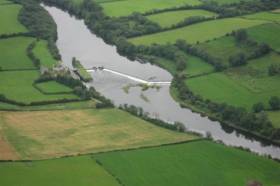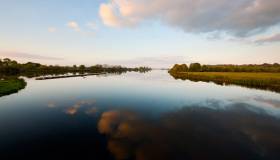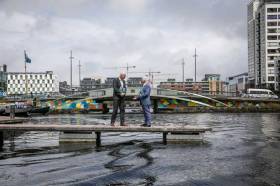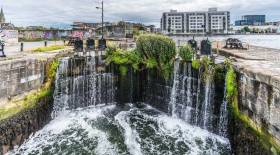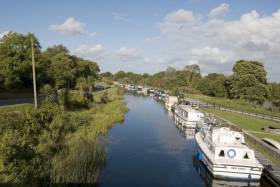Displaying items by tag: Waterways Ireland
Waterways Ireland Proposes To Refurbish Carnroe Weir On Lower Bann
Waterways Ireland is proposing extensive refurbishment works to the weir at Carnroe on the Lower Bann between Lough Neagh and Coleraine.
The cross-border body for Ireland’s inland waterways says Carnroe Weir is essential to the retention of water levels and boat movements along the length of the Lower Bann.
Works would be carried out over an 18-month period and in such a manner so as to conserve the heritage value of the current structure and to give a minimum operational life span of 75 years, Waterways Ireland adds.
The main in-river works would be undertaken in the summer months when water levels are typically lower.
In addition, the existing fish pass would be replaced with a new modern pass to comply with the requirements of Northern Ireland’s Department of Agriculture, Environment and Rural Affairs (Daera), which has responsibility for the fishery on the Lower Bann.
Waterways Ireland says it has engaged with consultants to undertake surveys and assessments, as well as consultations with landowners and other stakeholders, with a view to finalise details of the scheme and submit a planning application — including a full Environmental Impact Assessment — by the end of this month.
Waterways Ireland is proposing a permit system for the Shannon Navigation that could see users of Ireland’s longest river face charges for their boats for the first time, as The Irish Times reports.
Users of the Royal and Grand Canals must already pay for annual permits at a cost of €152 per vessel — and now the cross-border body for Ireland’s inland waterways is reviewing its by-laws for the Shannon with a view to extending similar charges there, as well as spot fines for breaches of regulations.
But what might be the biggest hit to Shannon boaters’ budgets may be the end of the current winter mooring regime.
Vessels can currently be moored at public harbours and jetties for five months at a cost of €83 per boat. This would be replaced under the plan with the summer ‘five-day rule’, which itself is under review.
However, the proposals would also bring an end to the current charges for the use of locks. A smartcard system for locks and bridges was rolled out on the Shannon Navigation last autumn.
The Irish Times has more on the story HERE.
The chief executives of Fáilte Ireland and Waterways Ireland met last week to discuss their new Strategic Partnership Programme to develop tourism along the latter’s network of inland waterways.
The agreement is focused on delivering “a programme of works to improve the quality of the visitor and user experience along Waterways Ireland’s waterways”, the cross-border body said in a statement.
These include the Barrow Navigation, Royal and Grand canals, Shannon-Erne Waterway and Shannon Navigation.
It’s aimed to link these projects with Fáilte Ireland’s regional brands the Wild Atlantic Way, Ireland’s Ancient East, Ireland’s Hidden Heartlands and Dublin.
And the partnership also involved cross-promotion and marketing efforts, such as Waterways Ireland’s Shannon Masterplan to develop sustainable tourism in the Shannon corridor, and future plans to encourage visitors’ engagement with the canals in Dublin city.
“The waterways are a key part of the tourism offering in rural Ireland and the Dublin region,” said Fáilte Ireland chief executive Paul Kelly.
“Unlocking the incredible tourism potential of waterways such as the Shannon River which flows through so many rural communities will mean generating a huge number of opportunities and growth in local economies.”
Waterways Ireland acting CEO John McDonagh added that the Shannon Masterplan in particular “is an excellent first step in our programme and we look forward to a fruitful partnership which benefits the communities and economies across our waterways”.
Waterways Ireland says it is currently preparing drawings and methodologies for a planning submission to Dublin City Council on works to replace the sea lock at Grand Canal Dock.
In 2018, the cross-border body for Ireland’s inland waterways commenced a programme of works to restore the lock chamber and gates in order to bring the lock back into operation.
The existing lock gates at Camden Lock, which date from the canal’s opening in 1796, are in a derelict state and have not been operated for over 30 years.
They are currently tied open, and the lock has been closed off by the installation of stop logs on the dock side of the chamber.
However, the Camden Lock chamber is generally in a good structural condition.
The lock structure, existing timber gates, all associated machinery including sluice boxes and gate winches, stones sets and limestone paving are all designated and classified as a heritage structure.
Initial regeneration works by the Dublin Docklands Development Authority beginning in 2002 concentrated on decontamination of the land at Grand Canal Dock.
Redevelopment of the area has continued steadily since then and includes the Bord Gais Energy Theatre, Google Docks and numerous new apartment buildings located along the perimeter of the dock.
The proposed works for Camden Lock are split in two distinct areas, beginning with preparatory works:
- Installation of temporary steel stop logs
- De-watering the lock, dredging and sediment removal from the lock floor and initial cleaning of the walls
- Removal of the existing derelict gates
Surveying of the lock chamber and existing gates in advance of construction of the new gates
This phase would be followed by the refurbishment works:
- Installation of new timber lock gates (replicas of the existing), including new access for all pedestrian walkway over the breast gates
- Installation of hydraulic rams, to allow for automation of the new gates
- Aquatic vegetation removal, racking out and repointing of joints
- Preservation of the integrity of the heritage site, including: all gate machinery, winch mechanisms, wheels, pot and pintels; wall ring insets; stone sets and limestone paving
Despite the growing demand for houseboat living in Ireland, there are only 28 residential moorings across the whole of the country, as RTÉ Radio 1’s Morning Ireland reports today (Wednesday 3 July).
Grand Canal Dock alone has a waiting list of some 215 hopefuls for its 20 places, and the programme hears from some of those fortunate enough to have made their home on Ireland’s inland waterways.
Waterways Ireland says it received as many as 10 queries a week from prospective houseboat residents — who will likely be waiting some time as only Grand Canal Dock and Shannon Harbour, with eight moorings, have provision for live-aboard homes.
Others make do with part-time waterways living, using the current 90-day permits to move around the country’s canals and rivers.
But with demand on the increase, it’s a situation that Waterways Ireland acknowledges has to change. RTÉ Radio 1 has more on the report HERE.
Waterways Ireland has issued Marine Notices related to a number of events taking place on Ireland’s inland waterways this weekend.
On the Royal Canal, a Junior Canoe Polo Competition will take place at Kilcock Harbour from 10am to 6pm tomorrow, Saturday 22 June.
Passage will be possible between 1pm and 2pm. Masters of other craft are requested to proceed at slow speed and with minimum wash and note any directions issued by the stewards.
On the Shannon-Erne Waterway, masters and owners of vessels are advised that they may experience short-term delays between Lock 1 at Corraquill and Ballyconnell Marina between 1pm and 6.30pm tomorrow due to the waterway’s 25th anniversary event.
Masters are requested to proceed at slow speed and heed any instructions issued by the event marshals.
Elsewhere on the River Shannon, the swimming element of a triathlon event will take place in Tarmonbarry on Sunday 23 June between 9.30am and noon.
Tarmonbarry lock will be closed to traffic during this time, and the N5 Shannon lifting bridge will also be closed, requiring large airdraft vessels to berth north of the bridge for the period.
A children’s swimming event will take place at 6pm on Saturday in Tarmonbarry, but this will not affect vessels in the navigation.
Masters are requested to proceed at slow speed and with minimum wash when approaching this section of the river and heed any instructions issued by the event marshals.
Meanwhile, on Upper Lough Erne, masters and owners of vessels are advised that dredging works are due to commence at Kilmore Quay on Monday 1 July and last for approximately nine weeks.
The map below shows the area to be dredged and the route the vessels will be taking in order to bottom-dump the material.
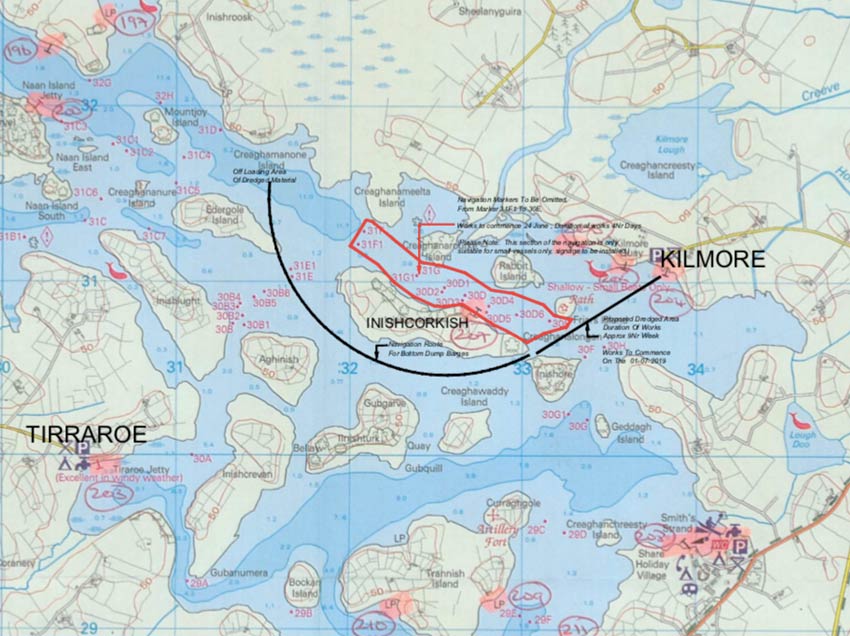
Masters of vessel are requested to proceed with additional caution in the vicinity of the dredging operations and dredging vessels.
Waterways Ireland thanks its customers for their co-operation in this and all other matters.
Hundreds of School Children Take Part In 2019 Biodiversity Week Programmes On Ireland’s Waterways
More than 600 primary level students across Ireland and Northern Ireland participated in Biodiversity Week workshops through Waterways Ireland’s education programme.
Biodiversity Week is one of seven different education programmes organised free of charge by Waterways Ireland both in the classroom and on the water throughout the school year.
This past week, seven workshops involving schoolchildren from 15 schools took place on Ireland’s inland waterways in Naas on the Naas branch, Drumshanbo on the River Shannon, Toomebridge on the Lower Bann, Mosstown on the Royal Canal, Ballyconnell on the Shannon-Erne Waterway, Robertstown on the Grand Canal, Killaloe on the River Shannon and Enniskillen on the Erne.
Tailored to each individual area, the workshops aimed to connect people with nature and communicate the importance of biodiversity, motivating people to play their part in protecting it.
It’s also about entertaining, showing the fun and wonder that can be found in nature, and inspiring people to learn more, see more and do more.
Students discovered the vast array of wildlife that call the waterways their home. Each group learned how to identify some of the plants and trees along the waterway and came face to face with some mini-beasts living there.
Environmental experts from across a range of disciplines delivered the workshops in conjunction with Waterways Ireland education and environment teams.
The Shannon-Erne Waterway begins its 25th year of operation tomorrow, Thursday 23 May.
It also marks start of a year of community, heritage and fun events all along the waterway linking Lough Erne in Co Fermanagh, through Co Cavan and into the River Shannon in Co Leitrim, taking in many towns and villages along its 63km length.
The largest cross-border infrastructure project of its time, the works involved the restoration of locks, dredging of the navigation channel, the installation of an electro-hydraulic lock operating system and the use of smart cards to operate the locks and service blocks which were placed at six locations along its length.
The Shannon-Erne Waterway has welcomed thousands of local and international boaters over the years, and introduced northern boaters to the south and southern boaters to the north, all bringing an economic dividend to places like Leitrim village, Keshcarrigan, Ballinamore and Ballyconnell.
Tomorrow the first of the year’s events, the Paddles Up Transition Year Programme reaches, its climax with a group of 100 students crossing the border on a 10km kayak paddle from the south to the north.
Paddles Up is a six-week programme involving learning the basic skills of kayaking and water safety and culminating in a 10km paddle. The students completing the programme will receive a qualification awarded by Canoeing Ireland, the national governing body, in either a Level One or Two Kayaking Proficiency Skills.
Further events are planned for the year including a visit of heritage boats to the Ballinamore Festival, exhibitions of heritage materials, oral history recordings and much more.
This include the Shannon-Erne Oral History Project, which is inviting contributions from people with memories of the waterway over the last 25 years.
Communities and activity clubs along the Shannon–Erne Waterway interested in organising events between now and May 2020 are asked to contact Waterways Ireland at [email protected] to be added to the events calendar.
To find out more about what’s on, find Waterways Ireland on Facebook.
Minister for Culture, Heritage and the Gaeltacht, Josepha Madigan, announced a new strategic partnership between Waterways Ireland and Rowing Ireland during the Get Going, Get Rowing #Blitzit Festival of Rowing on Grand Canal Dock on 9 May.
The partnership will seek to promote rowing programmes and clubs on the over 1,000km of inland waterways managed by Waterways Ireland.
It will also see a range of Rowing Ireland programmes, including Row for Life, the Get Going Get Rowing schools programme and Transition Year rowing coach programme, avail of Waterways Ireland facilities and sites to help promote improved levels of fitness, health and wellness across all ages in a fun and sociable environment.
Waterways Ireland, which is under the aegis of the Department of Culture, Heritage and the Gaeltacht, says it has seen a huge increase in the number of recreational users on and along all the waterways in recent years and there is now even more opportunity for people to try new recreational activities.
The new partnership allows Waterways Ireland and Rowing Ireland to join forces in promoting the health and well-being and social opportunities that are available through rowing in the great outdoors.
“For Waterways Ireland, partnerships are an ideal opportunity to encourage people to see inland waterways as a fitness and recreational opportunity for them,” said Sharon Lavin, head of marketing and communications at Waterways Ireland.
“Through working at a strategic level with Rowing Ireland, further programmes will be developed and people young and old will learn skills to help them stay fit and healthy for life.”
Rowing Ireland chief executive Michelle Carpenter added: “Our Get Going, Get Rowing programme — that has engaged 30,000 individual students in 2018 — is key to transitioning those from our school's programme to on the water rowing and activity on the water for life and our clubs.
“These values are significant elements of our strategic plan and we are thrilled to work hand in hand with our partners in Waterways Ireland.”
Further information on rowing programmes under this partnership can be found at RowingIreland.ie and www.WaterwaysIreland.org.
John McDonagh has been appointed acting chief executive officer of Waterways Ireland, the cross-border body for inland waterways accountable to the North South Ministerial Council under the 1998 British-Irish Agreement.
McDonagh is an English, history and politics graduate of UCD and he holds a Master’s in finance from the National College of Ireland.
He spent much of his career working in Shell Ireland and was formerly country manager. Prior to joining Waterways Ireland, McDonagh was sales and marketing director in Liberty Insurance. He has also consulted on a variety of projects across multiple sectors.


























